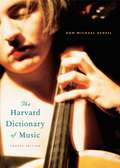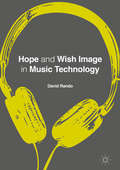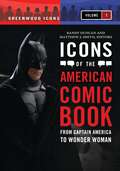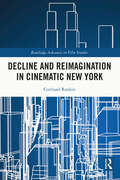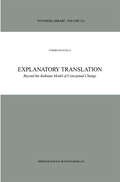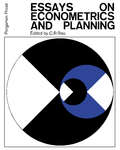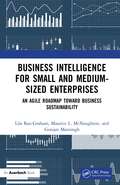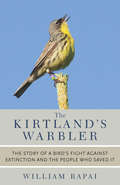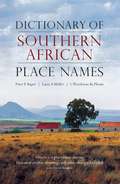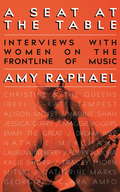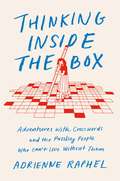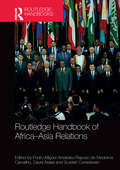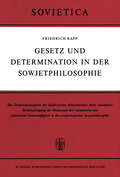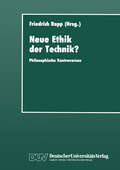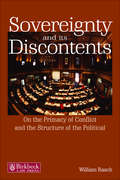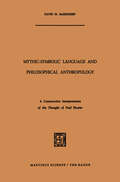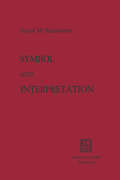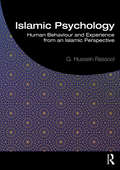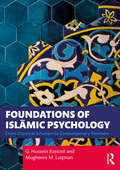- Table View
- List View
The Harvard Dictionary of Music: Fourth Edition (Harvard University Press Reference Library #10)
by Don Michael RandelThis classic reference work, the best one-volume music dictionary available, has been brought completely up to date in this new edition. Combining authoritative scholarship and lucid, lively prose, the Fourth Edition of The Harvard Dictionary of Music is the essential guide for musicians, students, and everyone who appreciates music.
Hope and Wish Image in Music Technology
by David P. RandoThis book proposes that new music technologies attract unconscious desires for socialism and collectivity, enabling millions of people living under capitalism to dream of repressed social alternatives. Grounded in the philosophical writings of Ernst Bloch and Walter Benjamin, the book examines file sharing technologies, streaming services, and media players, as well as their historical antecedents, such as the player piano, cassette tape, radio and compact disc, alongside interpretations of fiction, memoir, and albums. Through the concept of wish images—the unconscious hopes and desires for social alternatives that gather around new technologies—the book identifies the repressed pre- and post-capitalist urges that attend our music technologies. While these desires typically remain unconscious and tend to pass away not only unmet but also unrecognized, Hope and Wish Image in Music Technology attempts to bring wishes for social alternatives to the surface at an auspicious moment of technological transition.
Hope and Wish Image in Music Technology (PDF)
by David P. RandoThis book proposes that new music technologies attract unconscious desires for socialism and collectivity, enabling millions of people living under capitalism to dream of repressed social alternatives. Grounded in the philosophical writings of Ernst Bloch and Walter Benjamin, the book examines file sharing technologies, streaming services, and media players, as well as their historical antecedents, such as the player piano, cassette tape, radio and compact disc, alongside interpretations of fiction, memoir, and albums. Through the concept of wish images—the unconscious hopes and desires for social alternatives that gather around new technologies—the book identifies the repressed pre- and post-capitalist urges that attend our music technologies. While these desires typically remain unconscious and tend to pass away not only unmet but also unrecognized, Hope and Wish Image in Music Technology attempts to bring wishes for social alternatives to the surface at an auspicious moment of technological transition.
Icons of the American Comic Book [2 volumes]: From Captain America to Wonder Woman [2 volumes] (Greenwood Icons)
by Randy Duncan and Matthew J. SmithThis book explores how the heroes and villains of popular comic books—and the creators of these icons of our culture—reflect the American experience out of which they sprang, and how they have achieved relevance by adapting to, and perhaps influencing, the evolving American character.Multiple generations have thrilled to the exploits of the heroes and villains of American comic books. These imaginary characters permeate our culture—even Americans who have never read a comic book grasp what the most well-known examples represent. But these comic book characters, and their creators, do more than simply thrill: they make us consider who we are and who we aspire to be.Icons of the American Comic Book: From Captain America to Wonder Woman contains 100 entries that provide historical background, explore the impact of the comic-book character on American culture, and summarize what is iconic about the subject of the entry. Each entry also lists essential works, suggests further readings, and contains at least one sidebar that provides entertaining and often quirky insight not covered in the main entry. This two-volume work examines fascinating subjects, such as how the superhero concept embodied the essence of American culture in the 1930s; and the ways in which comic book icons have evolved to reflect changing circumstances, values, and attitudes regarding cultural diversity. The book's coverage extends beyond just characters, as it also includes entries devoted to creators, publishers, titles, and even comic book related phenomena that have had enduring significance.
Decline and Reimagination in Cinematic New York (Routledge Advances in Film Studies)
by Cortland RankinDecline and Reimagination in Cinematic New York examines the cinematic representation of New York from the mid-1960s through the mid-1980s, placing the dominant discourse of urban decline in dialogue with marginal perspectives that reimagine the city along alternative paths as a resilient, adaptive, and endlessly inspiring place. Drawing on mainstream, independent, documentary, and experimental films, the book offers a multifaceted account of the power of film to imagine the city’s decline and reimagine its potential. The book analyzes how filmmakers mobilized derelict space and various articulations of “nature” as settings and signifiers that decenter traditional understandings of the city to represent New York alternately as a desolate wasteland, a hostile wilderness, a refuge and playground for outcasts, a home to resilient and resourceful communities, a studio for artistic experimentation, an arcadia conducive to alternative social arrangements, and a complex ecosystem. This book will be of interest to scholars and students of film studies, media studies, urban cinema, urban studies, and eco-cinema.
Decline and Reimagination in Cinematic New York (Routledge Advances in Film Studies)
by Cortland RankinDecline and Reimagination in Cinematic New York examines the cinematic representation of New York from the mid-1960s through the mid-1980s, placing the dominant discourse of urban decline in dialogue with marginal perspectives that reimagine the city along alternative paths as a resilient, adaptive, and endlessly inspiring place. Drawing on mainstream, independent, documentary, and experimental films, the book offers a multifaceted account of the power of film to imagine the city’s decline and reimagine its potential. The book analyzes how filmmakers mobilized derelict space and various articulations of “nature” as settings and signifiers that decenter traditional understandings of the city to represent New York alternately as a desolate wasteland, a hostile wilderness, a refuge and playground for outcasts, a home to resilient and resourceful communities, a studio for artistic experimentation, an arcadia conducive to alternative social arrangements, and a complex ecosystem. This book will be of interest to scholars and students of film studies, media studies, urban cinema, urban studies, and eco-cinema.
Explanatory Translation: Beyond the Kuhnian Model of Conceptual Change (Synthese Library #312)
by V. RantalaIn this book, the author makes a systematic attempt to understand cognitive characteristics of translation by bringing its logical, pragmatic and hermeneutic features together and examining a number of scientific, logical, and philosophical applications. The book is for philosophers of science, linguists, logicians, historians of science, and scientists interested in philosophical questions of scientific change.
Essays on Econometrics and Planning
by C. R. RaoEssays on Econometrics and Planning provides a compilation of papers pertinent to econometrics and planning. This book covers a variety of topics, including competition, planner's capital, parametric solution and programming, economic system, and economic growth.Organized into 22 chapters, this book begins with an overview of the concepts of cooperation, conflict, exploitation, and competition in relation to economic system. This text then examines the status of economic planning in Great Britain and provides an analysis of the role of autonomous investment in the economy. Other chapters consider the monetary or financial aspects of the Soviet economy. This book discusses as well the aspects in which the planners have a social location and economic preferences different from those of the mass of citizens in the underdeveloped country. The final chapter deals with the problem of national development.This book is a valuable resource for economists, industrialists, economic planners, and academic socialists.
Business Intelligence for Small and Medium-Sized Enterprises: An Agile Roadmap toward Business Sustainability
by Lila Rao-Graham Maurice L. McNaughton Gunjan MansinghBusiness intelligence (BI) has evolved over several years as organizations have extended their online transaction processing (OLTP) capabilities and applications to support their routine operations. With online analytical processing (OLAP), organizations have also established the capability to extract internal and external data from a variety of sources to specifically obtain intelligence about non-routine and often less-structured arrangements. BI therefore refers to applications and technologies that are used to gather, provide access to, and analyze data and information about the operations of an organization. It has the capability of providing comprehensive insight into the more volatile factors affecting the business and its operations, thereby facilitating enhanced decision-making quality and contributing to the creation of business value. Larger and more sophisticated organizations have long been exploiting these capabilities. Business Intelligence for Small and Medium-Sized Enterprises (SMEs) guides SMEs in replicating this experience to provide an agile roadmap toward business sustainability. The book points out that successful BI implementations have generated significant increases in revenue and cost savings, however, the failure rates are also very high. More importantly, it emphasizes that a full range of BI capabilities is not the exclusive purview of large organizations. It shows how SMEs make extensive use of BI techniques to develop the kind of agility endowing them with the organizational capability to sense and respond to opportunities and threats in an increasingly dynamic business environment. It points to the way to a market environment in which smaller organizations could have a larger role. In particular, the book explains that by establishing the agility to leverage internal and external data and information assets, SMEs can enhance their competitiveness by having a comprehensive understanding of the key to an agile roadmap for business sustainability.
Business Intelligence for Small and Medium-Sized Enterprises: An Agile Roadmap toward Business Sustainability
by Lila Rao-Graham Maurice L. McNaughton Gunjan MansinghBusiness intelligence (BI) has evolved over several years as organizations have extended their online transaction processing (OLTP) capabilities and applications to support their routine operations. With online analytical processing (OLAP), organizations have also established the capability to extract internal and external data from a variety of sources to specifically obtain intelligence about non-routine and often less-structured arrangements. BI therefore refers to applications and technologies that are used to gather, provide access to, and analyze data and information about the operations of an organization. It has the capability of providing comprehensive insight into the more volatile factors affecting the business and its operations, thereby facilitating enhanced decision-making quality and contributing to the creation of business value. Larger and more sophisticated organizations have long been exploiting these capabilities. Business Intelligence for Small and Medium-Sized Enterprises (SMEs) guides SMEs in replicating this experience to provide an agile roadmap toward business sustainability. The book points out that successful BI implementations have generated significant increases in revenue and cost savings, however, the failure rates are also very high. More importantly, it emphasizes that a full range of BI capabilities is not the exclusive purview of large organizations. It shows how SMEs make extensive use of BI techniques to develop the kind of agility endowing them with the organizational capability to sense and respond to opportunities and threats in an increasingly dynamic business environment. It points to the way to a market environment in which smaller organizations could have a larger role. In particular, the book explains that by establishing the agility to leverage internal and external data and information assets, SMEs can enhance their competitiveness by having a comprehensive understanding of the key to an agile roadmap for business sustainability.
The Kirtland's Warbler: The Story of a Bird's Fight Against Extinction and the People Who Saved It
by William RapaiThis book looks at the Kirtland’s warbler and wildlife conservation in a way that no other book has. It looks back on the history of this unique bird, examines the people and policies that kept the warbler from extinction, explores the cult of personality that surrounds it, and examines the challenges of the future—all through the eyes of the people who have acted so passionately on its behalf. The story of the Kirtland’s warbler is a story of complex relationships between the bird and its environment, the humans who interact with it, and the complex government policies that affect it. And now, just when it appears that the Kirtland’s warbler has recovered for good, a change in its status may send the warbler’s population into a downward spiral once again.
Dictionary of Southern African Place Names
by Peter E Raper Lucie A Moller Theodorus L du PlessisThe Dictionary of Southern African Place Names - now in its 4th edition - helps you sort your Komkhulu from your Kommetjie with the most comprehensive glossary of Southern African towns, villages, railway stations, mountains, rivers and beaches. The 9 000 short entries incorporate data from sources dating as far back as 1486, encapsulating the linguistic and cultural heritage of all the peoples of the subcontinent, past and present. In this highly readable book the expert authors take you on a fascinating journey of the highways and byways of Southern Africa. Whether you are a motorist, an adventurer or merely an armchair traveller, this book has a multitude of facts and details that will fascinate you. This is much more than a reference book - it gives an insight into what shapes a place and its people through our heroes, events, beliefs, values, fears and aspirations.
A Seat at the Table: Interviews with Women on the Frontline of Music
by Amy Raphael'Fascinating and illuminating' STYLIST'Perceptive and candid' IRISH TIMES'A fascinating, brilliant book, full of joy, rage, a love of music' THE SKINNY'Variously optimistic, troubling, joyful, illuminating, fierce and thoughtful' GUARDIANINTERVIEWS WITH WOMEN ON THE FRONTLINE OF MUSIC, from KATE TEMPEST to MAGGIE ROGERS, CHRISTINE AND THE QUEENS to IBEYI.Writer and critic Amy Raphael has interviewed some of the world's most iconic musicians, including Courtney Love, Patti Smith, Björk, Kurt Cobain and Elton John. In 1995 she wrote the critically-acclaimed Never Mind the Bollocks: Women Rewrite Rock, which included a foreword by Debbie Harry. More than two decades on, the music business has changed, but the way women are regarded has not. In this new book, A Seat at the Table, Raphael interviews eighteen women who work in the music industry about learning to speak out, #MeToo, social media, queer politics and the subtleness of everyday misogyny. Featuring interviews with:CHRISTINE & THE QUEENSIBEYI KATE TEMPESTALISON MOYETNADINE SHAHJESSICA CURRYMAGGIE ROGERSEMMY THE GREATDREAM WIFENATALIE MERCHANTLAUREN MAYBERRYPOPPY AJUDHAKALIE SHORRTRACEY THORNMITSKICATHERINE MARKS GEORGIACLARA AMFO
Thinking Inside the Box: Adventures with Crosswords and the Puzzling People Who Can't Live Without Them
by Adrienne Raphel'Beautifully researched account, full of humour and personal insight'David Crystal, author of Making Sense: The Glamorous Story of English Grammar'A witty, wise, and wonderfully weird journey that will change the way you think . . . This book is a delight'Bianca Bosker, author of Cork Dork: A Wine-Fueled Adventure Among the Obsessive Sommeliers, Big Bottle Hunters, and Rogue Scientists Who Taught Me to Live for Taste'Delightfully engrossing, charmingly and enthusiastically well-written history of the crossword puzzle' Benjamin Dreyer, author of Dreyer's English: An Utterly Correct Guide to Clarity and Style 'Full of treasures, surprises and fun . . . richly bringing to life the quirky, obsessive, fascinating characters in the crossword world' Mary Pilon, author of The Monopolists: Obsession, Fury, and the Scandal Behind the World's Favorite Board Game 'A gold mine of revelations. If there is a pantheon of cruciverbalist scholars, Adrienne Raphel has established herself squarely within it'Mary Norris, author of Between You & Me: Confessions of a Comma QueenEqual parts ingenious and fun, Thinking Inside the Box is a love letter to the infinite joys and playful possibilities of language, a treat for die-hard cruciverbalists and first-time crossword solvers alike.The crossword is a feature of the modern world, inspiring daily devotion and obsession from millions. It was invented in 1913, almost by accident, when an editor at the New York World was casting around for something to fill some empty column space for that year's Christmas edition. Almost overnight, crosswords became a phenomenal commercial success, and have been an essential ingredient of any newspaper worth its salt since then. Indeed, paradoxically, the popularity of crosswords has never been greater, even as the world of media and newspapers, the crossword's natural habitat, has undergone a dramatic digital transformation. But why, exactly, are the satisfactions of a crossword so sweet that over the decades they have become a fixture of breakfast tables, bedside tables and commutes, and even given rise to competitive crossword tournaments?Blending first-person reporting from the world of crosswords with a delightful telling of the crossword's rich literary history, Adrienne Raphel dives into the secrets of this classic pastime. At the annual American Crossword Puzzle Tournament, she rubs shoulders with elite solvers from all over the world, doing her level best to hold her own; aboard a crossword-themed cruise she picks the brains of the enthusiasts whose idea of a good time is a week on the high seas with nothing to do but crosswords; and, visiting the home and office of Will Shortz, New York Times crossword puzzle editor and US National Public Radio's official Puzzlemaster, she goes behind the scenes to see for herself how the world's gold standard of puzzles is made.
Routledge Handbook of Africa-Asia Relations
by Pedro Amakasu Raposo David Arase Scarlett CornelissenThe Routledge Handbook of Africa–Asia Relations is the first handbook aimed at studying the interactions between countries across Africa and Asia in a multi-disciplinary and comprehensive way. Providing a balanced discussion of historical and on-going processes which have both shaped and changed intercontinental relations over time, contributors take a thematic approach to examine the ways in which we can conceptualise these two very different, yet inextricably linked areas of the world. Using comparative examples throughout, the chronological sections cover: • Early colonialist contacts between Africa and Asia; • Modern Asia–Africa interactions through diplomacy, political networks and societal connections; • Africa–Asia contemporary relations, including increasing economic, security and environmental cooperation. This handbook grapples with major intellectual questions, defines current research, and projects future agendas of investigation in the field. As such, it will be of great interest to students of African and Asian Politics, as well as researchers and policymakers interested in Asian and African Studies.
Gesetz und Determination in der Sowjetphilosophie: Zur Gesetzeskonzeption des dialektischen Materialismus unter besonderer Berücksichtigung der Diskussion über dynamische und statistische Gesetzmäßigkeit in der zeitgenössischen Sowjetphilosophie (Sovietica #26)
by F. RappSovereignty and its Discontents: On the Primacy of Conflict and the Structure of the Political (Birkbeck Law Press)
by William RaschThis book argues for the centrality of conflict in any notion of the political. In contrast to many of the attempts to re-think the political in the wake of the collapse of traditional leftist projects, it also argues for the logical and/or ontological primacy of violence over 'peace'. The notion of the political expounded here is explicitly 'realist' and anti-utopian - in large part because the author finds the consequences of attempting to think 'the good life' to be far more damaging than thinking 'the tolerable life'. The political is not thought of as a means to implement the good life; rather, the political exists because the good life does not. Indeed, if one sees 'globalization', with its emphasis on efficiency and economy, as a threat to the autonomy of the political, then one ought to be wary of political ideologies that reduce the political to species of moral or legal discourse. As laudable as the aims of human rights activists or political theorists like Rawls and Habermas may be, the consequences of their thought and actions further reduce the scope and possibility of political activity by, in effect, criminalizing political opposition. Once 'universal' norms are instantiated, political opposition becomes impossible. A fully legalized, moralized, and pacified universe is a thoroughly depoliticized one as well. Academics and advanced students researching and working in the areas of political theory, legal theory and international relations will find this book of great interest.
Sovereignty and its Discontents: On the Primacy of Conflict and the Structure of the Political (Birkbeck Law Press)
by William RaschThis book argues for the centrality of conflict in any notion of the political. In contrast to many of the attempts to re-think the political in the wake of the collapse of traditional leftist projects, it also argues for the logical and/or ontological primacy of violence over 'peace'. The notion of the political expounded here is explicitly 'realist' and anti-utopian - in large part because the author finds the consequences of attempting to think 'the good life' to be far more damaging than thinking 'the tolerable life'. The political is not thought of as a means to implement the good life; rather, the political exists because the good life does not. Indeed, if one sees 'globalization', with its emphasis on efficiency and economy, as a threat to the autonomy of the political, then one ought to be wary of political ideologies that reduce the political to species of moral or legal discourse. As laudable as the aims of human rights activists or political theorists like Rawls and Habermas may be, the consequences of their thought and actions further reduce the scope and possibility of political activity by, in effect, criminalizing political opposition. Once 'universal' norms are instantiated, political opposition becomes impossible. A fully legalized, moralized, and pacified universe is a thoroughly depoliticized one as well. Academics and advanced students researching and working in the areas of political theory, legal theory and international relations will find this book of great interest.
Mythic-Symbolic Language and Philosophical Anthropology: A Constructive Interpretation of the Thought of Paul Ricœur
by David M. RasmussenThis book will attempt to achieve a constructive and positive correla tion between mythic-symbolic language and philosophical anthropolo gy. It is intended as a reflection on the philosophical accomplishment of Paul Ricoeur. The term mythic-symbolic language in this context means the language of the multivalent symbol given in the myth with its psychological and poetic counterparts. The term symbol is not con ceived as an abstract sign as it is used in symbolic logic, but rather as a concrete phenomenon - religious, psychological, and poetic. The task inherent in this correlation is monumental when one considers the dual dilemma of problematic and possibility which is at its heart. The prob lematic arises out of the apparent difficulty presented by the so-called challenge of modernity which seems to require the elimination of my thic-symbolic language as an intelligible mode of communication. Mythic-symbolic language is sometimes eliminated because in a world molded by abstract conceptualizations of science, such a language is thought to be unintelligible. The claim is that its "primitive" explana tions have been transcended by our modernity. Others believe that the problem of mythic-symbolic language is the problem of the myth. If the mythic forms of language could be eliminated, the truth of such language could be preserved through its translation into an intelligible mode of discourse. The problematic is heightened further by the relation of consider ations of language to philosophical anthropology. Any consideration of language involves a related view of the nature of man.
Symbol and Interpretation
by D.M. RasmussenFor the past four or five years much of my thinking has centered up on the relationship of symbolic forms to philosophic imagination and interpretation. As one whose own philosophic speculations began at. the end of a cultural epoch under methodologies dominated either by neo-Kantianism or schools of logical empiricism the symbol as a prod uct of a cultural imagination has been diminished; it has been neces sary for those who wanted to preserve the symbol to find appropriate philosophical methodologies to do so. In the following chapters we shall attempt to show, through a consideration of a series of recent interpretations of the symbol, as well as through constructive argu ment, that the symbol ought to be considered as a linguistic form in the sense that it constitutes a special language with its own rubrics and properties. There are two special considerations to be taken ac count of in this argument; first, the definition of the symbol, and sec ond, the interpretation of the symbol. Although we shall refrain from defining the symbol explicitly at this point let it suffice to state that our definition of the symbol is more aesthetic than logical (in the technical sense of formal logic ), more cultural than individual, more imaginative than scientific. The symbol in our view is somewhere at the center of culture, the well-spring which testifies to the human imagination in its poetic, psychic, religious, social and political forms.
Islamic Psychology: Human Behaviour and Experience from an Islamic Perspective
by G. Hussein RassoolIslamic Psychology or ilm an-nafs (science of the soul) is an important introductory textbook drawing on the latest evidence in the sub-disciplines of psychology to provide a balanced and comprehensive view of human nature, behaviour and experience. Its foundation to develop theories about human nature is based upon the writings of the Qur'an, Sunna, Muslim scholars and contemporary research findings. Synthesising contemporary empirical psychology and Islamic psychology, this book is holistic in both nature and process and includes the physical, psychological, social and spiritual dimensions of human behaviour and experience. Through a broad and comprehensive scope, the book addresses three main areas: Context, perspectives and the clinical applications of applied psychology from an Islamic approach. This book is a core text on Islamic psychology for undergraduate and postgraduate students and those undertaking continuing professional development in Islamic psychology, psychotherapy and counselling. Beyond this, it is also a good supporting resource for teachers and lecturers in this field.
Islamic Psychology: Human Behaviour and Experience from an Islamic Perspective
by G. Hussein RassoolIslamic Psychology or ilm an-nafs (science of the soul) is an important introductory textbook drawing on the latest evidence in the sub-disciplines of psychology to provide a balanced and comprehensive view of human nature, behaviour and experience. Its foundation to develop theories about human nature is based upon the writings of the Qur'an, Sunna, Muslim scholars and contemporary research findings. Synthesising contemporary empirical psychology and Islamic psychology, this book is holistic in both nature and process and includes the physical, psychological, social and spiritual dimensions of human behaviour and experience. Through a broad and comprehensive scope, the book addresses three main areas: Context, perspectives and the clinical applications of applied psychology from an Islamic approach. This book is a core text on Islamic psychology for undergraduate and postgraduate students and those undertaking continuing professional development in Islamic psychology, psychotherapy and counselling. Beyond this, it is also a good supporting resource for teachers and lecturers in this field.
Foundations of Islāmic Psychology: From Classical Scholars to Contemporary Thinkers
by G. Hussein Rassool Mugheera M. LuqmanFoundations of Islāmic Psychology: From Classical Scholars to Contemporary Thinkers examines the history of Islāmic psychology from the Islāmic Golden age through the early 21st century, giving a thorough look into Islāmic psychology’s origins, Islāmic philosophy and theology, and key developments in Islāmic psychology. In tracing psychology from its origins in early civilisations, ancient philosophy, and religions to the modern discipline of psychology, this book integrates overarching psychological principles and ideas that have shaped the global history of Islāmic psychology. It examines the legacy of psychology from an Islāmic perspective, looking at the contributions of early Islāmic classical scholars and contemporary psychologists, and to introduce how the history of Islāmic philosophy and sciences has contributed to the development of classical and modern Islāmic psychology from its founding to the present. With each chapter covering a key thinker or moment, and also covering the globalisation of psychology, the Islāmisation of knowledge, and the decolonisation of psychology, the work critically evaluates the effects of the globalisation of psychology and its lasting impact on indigenous culture. This book aims to engage and inspire students taking undergraduate and graduate courses on Islāmic psychology, to recognise the power of history in the academic studies of Islāmic psychology, to connect history to the present and the future, and to think critically. It is also ideal reading for researchers and those undertaking continuing professional development in Islāmic psychology, psychotherapy, and counselling.
Foundations of Islāmic Psychology: From Classical Scholars to Contemporary Thinkers
by G. Hussein Rassool Mugheera M. LuqmanFoundations of Islāmic Psychology: From Classical Scholars to Contemporary Thinkers examines the history of Islāmic psychology from the Islāmic Golden age through the early 21st century, giving a thorough look into Islāmic psychology’s origins, Islāmic philosophy and theology, and key developments in Islāmic psychology. In tracing psychology from its origins in early civilisations, ancient philosophy, and religions to the modern discipline of psychology, this book integrates overarching psychological principles and ideas that have shaped the global history of Islāmic psychology. It examines the legacy of psychology from an Islāmic perspective, looking at the contributions of early Islāmic classical scholars and contemporary psychologists, and to introduce how the history of Islāmic philosophy and sciences has contributed to the development of classical and modern Islāmic psychology from its founding to the present. With each chapter covering a key thinker or moment, and also covering the globalisation of psychology, the Islāmisation of knowledge, and the decolonisation of psychology, the work critically evaluates the effects of the globalisation of psychology and its lasting impact on indigenous culture. This book aims to engage and inspire students taking undergraduate and graduate courses on Islāmic psychology, to recognise the power of history in the academic studies of Islāmic psychology, to connect history to the present and the future, and to think critically. It is also ideal reading for researchers and those undertaking continuing professional development in Islāmic psychology, psychotherapy, and counselling.
